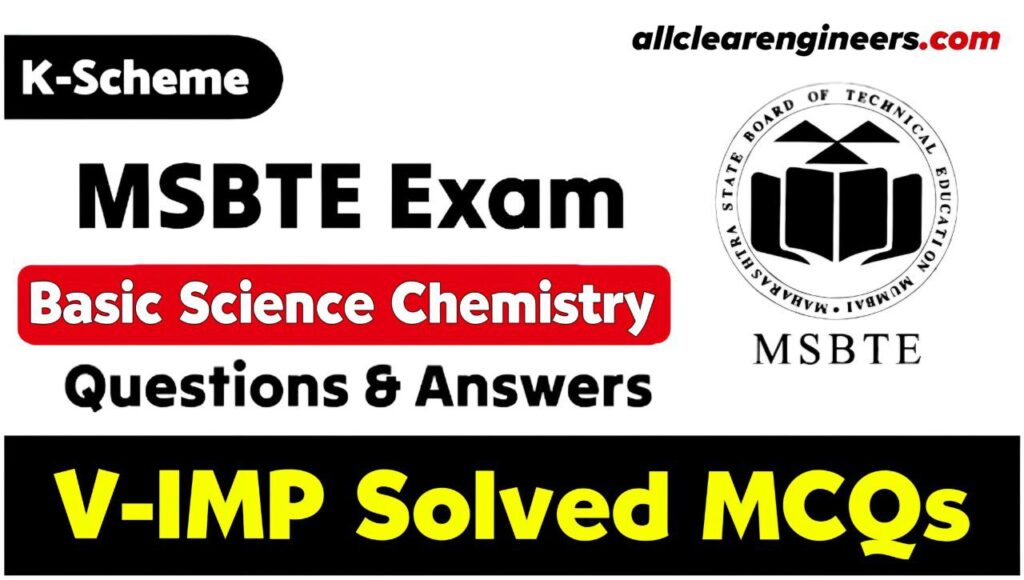311305 Basic Science Physics MCQs
MSBTE Chemsitry All Unit Solved MCQs with Explanation
Q1
Metals lose electrons from their lattice to become ……….
Q2
Dative Covalent bond is found in ………
Q3
Charge on any ion depends upon gain or loss of ………
Q4
Metals and Non- metals combine to give electronic configuration of ……….
Q5
Noble gases exist as ……………
Q6
When magnesium reacts with oxygen, nature of the bond formed is ……….
Q7
Metals are good conductors due to ………
Q8
When a covalent bond is formed between hydrogen atom and a very electronegative atom, then it is known as……
Q9
Molecules which have permanent dipole are known as………
Q10
Electrovalent bond is another name of ………….
Q11
Covalent compounds are …………….
Q12
Crystal lattice is actually …………
Q13
Unit cell is the smallest building unit of ………………
Q14
Which of the following is an amorphous solid?
Q15
The co-ordinate number of FCC structure is…………..
Q16
The lattice site in a pure crystal cannot be occupied by ……………
Q17
Substance which alter the rate of chemical reaction without undergoing any chemical change are called as ………
Q18
The substance that reduce the effectiveness of a catalyst are called ………
Q19
When catalyst and reactant are in the same phase then it is called…….
Q20
When a product acts as a catalyst then it is called as ……….
Q21
Complete transfer of one or more electrons between atoms constituting in forming…………
Q22
When a single atom provides both electrons which are needed for completion of covalent bond then it leads to……
Q23
In ammonia ion, electrons required between hydrogen ion and nitrogen ion are…………
Q24
Pairs of outer shell electrons not used in bonding are called as………
Q25
Bond formed by sharing of four electrons is called as……………….
Q26
For dative covalent bonding, one atom having a lone pair of electrons combines with …
Q27
When the bond is formed by sharing of two pairs of electrons by atoms, then the bond is called as……..
Q28
Neither ions nor electrons are free to move in………………
Q29
Weak forces between molecules are called as………………………
Q30
Electrons are usually lost by…………………………….
Q31
In nitrogen molecule, numbers of electrons required by each nitrogen atom in outer shell are……………..
Q32
Conduction of electricity in metallic bonding is due to the presence of……………
Set 2
Q1
Nitrogen molecule is an example of ………………………….
Q2
Regular arrangement in which atoms are closely packed together is called a ……
Q3
Resulting a loss of electrons forms …………………………………
Q4
Representation of bond by single, double or triple line is done in…………………
Q5
Which of the following characteristic does not possess by the metal?
Q6
On which factor, conductance of metals is responsible?
Q7
The difference between the number of atoms in a unit cell of a BCC crystal and an FCC crystal is ………….
Q8
When partial positive end of one molecule is attracted weakly to partial negative end , then the force between them is…………………….
Q9
Tendency of atoms to acquire eight electrons in their valence shell is…………. …
Q10
In the formation of Mg++ ion. Which one is the correct reaction in the following?
Q11
What type of bond form between hydrogen & oxygen atom in the given structure?
Q12
The given figure represents
Q13
What type of interaction between δ+ & δ- ?
Q14
The catalyst used in the lead chamber process of sulphuric acid manufacturing
Q15
An example of autocatalytic reaction is …
Q16
The coordination number of a metal crystallizing in a hexagonal close packing (HCP) structure is
Q17
Which of the following compound possesses covalent bond?
Q18
Proton accelerate the hydrolysis of ester. This is an example of ………
Q19
Which of the following processes does not involve a catalyst?
Q20
Which of the following reaction is catalysed by enzyme maltase?
Q21
The transition metal used as a catalyst is…..
Q22
In the Ostwald’s process for the manufacture of HNO3, the catalyst used is……
Q24
Which of the following is not a category of catalysis?
Q25
Which of the following is an example of homogeneous catalysis ?
Q26
Which of the following statement is incorrect about the adsorption theory?
Q27
Which of the following process used for preparation of sulphuric acid?
Q28
Select the catalyst which is used for manufacturing of ethanol from glucose
Q29
Which of the following process is used for the preparation of Chlorine gas?
Q30
Name the catalyst which is used For manufacture of glucose from cane sugar.
‘
Q31
Name the metal which increase the activity of iron metal when added in small amount.
Q32
What is the role of Mo in following reaction:
Q33
The adsorption theory is applicable to …
Q34
Water accumulates in cells of animals and plants due to presence of …
Q35
Solid CO2 is an example of…….
Q36
Which of the following is Amorphous?
Q37
The property of crystalline solid is not
Q38
Characteristics features of solids are
Q39
Diamond is an example of
Q40
Which solid will have the weakest inter molecular forces?
Q41
Which of the following example of metallic crystal solid
Q42
Lead is a metallic crystal having a structure.
Q43
Which of the following has a HCP crystal structure?
Q44
Amorphous solids have structure.
Q45
Bravais lattice consists of space lattices.
Q46
Identify the lattice structure of given unit cell;
Q47
Identify the lattice structure of given unit cell;
Q48
Identify the lattice structure of given unit cell;
Q49
The coordination number of a metal crystal in a Simple Cubic (SC) structure is
Q50
The coordination number of a metal crystal in a Body centered cubic (BCC) structure is
Q51
The metal which is commonly used as a coating metal during electroplating of imitation jewellery is
Q52
The process due to which water splits into hydrogen ions and hydroxyl ions is
Q53
The method of electrolysis which is used to improve corrosion resistance of any metal
Q54
During electro refining of blister copper, anode and cathode respectively made up of
Q55
Which type of oxide film is formed on the surface of alkali and alkaline earth metal?
Q56
Identify the substance, which form physical barrier between metal and corroding medium and reduce the corrosion
Q57
The process used for repairing broken or worn out parts of machine is called
Q58
The organic or inorganic substances, which when added in small quantity to the corrosive environment, effectively minimize the corrosion of metal are called as
Q59
On which part of any metal, differential aeration type of corrosion will occur
Q60
Electro chemical equivalent of a metal is Y gm/coulomb. The equivalent weight of a metal is
Q61
Name the type of corrosion in the given situation copper sheets joint by iron nails and is exposed to humid environment
Q62
In electrochemical cells two half cells are in contact with each other by
Q63
In Zn/Zn++//Cu++/Cu cell, electrical energy is generated at the cost of
Q64
One of the method of preventing corrosion of metal by applying protective coating is
Q65
Select the volatile oxide film from the given option
Q66
Tin coated metal can be used for
Q67
Aqueous CuSO4 solution conducts electricity due to presence of
Q68
The process of decomposition of electrolyte in presence of electric current is called
Q69
The aluminum metal is corrosion resistance because of formation of oxide film which is
Q70
The best suitable alloying metal for iron or steel in cutlery is
Q71
Under the humid conditions, the reaction that occur at cathode when iron hinges plated with copper is
Q72
Name the metal used to protect the metal from corrosion by sacrificial anodic protection
Q73
The reaction taking place in oxygen absorption mechanism of iron in presence of neutral aqueous solution in excess supply of oxygen is
Q74
The product obtain at cathode during electrolysis of aqueous CuSO4 solution using platinum electrode is
Q75
The metal used in galvanizing to form protective coating on iron sheet is
Q76
One of the method used for the prevention of metal from corrosion by modification of environment is
Q77
In Daniel cell, anode and cathode respectively are made up of
Q78
Name the reaction taking place at anode in Daniel cell
Q79
Several blocks of Mg are fixed to the bottom of the ship to avoid
Q80
Reduction potential is the measure of tendency of electrode to
Q81
Relation between chemical equivalent and electrochemical equivalent is
Q82
During electro refining of blister copper 1% H2SO4 is added to electrolyte
Q83
Ammonium hydroxide considered as a weak electrolyte as in the aqueous solution it
Q84
Which of the following is nonelectrolyte?
Q85
When aqueous solution of silver nitrate is used as an electrolyte during electrolysis then the ions which moves towards the cathode is
Q87
The substance which in their aqueous/molten state produces ions & allow the electric current to pass through them are known as
Q88
The metal which is placed at the top of the electrochemical series is
Q89
Due to the passage of electric current, the electrolyte undergoes
Q90
The aqueous CuSO4 solution allows electric current to pass through it, hence it is called
Q91
During electrolysis, the ions moving towards the anode are
Q92
Pitting corrosion in stainless steel can be reduced by adding
Q93
Galvanized container are not used for storing food products because
Q94
During electrolysis 2 ampere of current is passed through CuSO4 & ZnSO4 solution which are connected in series, if amount of Cu deposited is 3.17 gm, calculate the amount of Zn deposited, Given C.E. of Cu is 31.75 & C.E. of Zn is 32.5
Q95
Calculate the weight of a substance deposited when current of 1.5 ampere is passed through solution for 30 minutes, given: E.C.E. =0.000337
Q96
Calculate the equivalent weight of substance if its electrochemical equivalent is 0.00032 gm
Q97
Choose the electrode at which oxidation takes place in electrochemical cell
Q98
Calculate the time in minutes, when 0.921 gm substance is deposited by passing current of 2.5 ampere through ZnSO4 solution for given ECE of Zn=0.000304
Q99
Underground part of buried electric pole undergoes corrosion due to
Q100
Calculate the chemical equivalent of Zn, when CuSO4 & ZnSO4 solutions are electrolyzed in series, the weight of a Cu & Zn deposited are 6.35 gm and 6.5 gm respectively. (given: atomic wt. of Cu=63.5 gm)
Q101
The electrolytic solution is
Q102
The process of attaching more active metal to an iron object for preventing from corrosion is
Q103
If 96500 coulomb of charge deposited 108 gm of silver, calculate the weight of silver deposited when 9650 coulomb of charge is passed
Q104
The technique particularly used for protection of underground pipeline in industry is called as
Q105
In which state the common salt does not conduct electricity?
Q106
Coating of which metal is anodic on steel according to galvanic cell
Q107
The weight of a substance liberated/deposit by passing one faraday of electricity is equal to,
Q108
Calculate E.C.E. of Cu, if atomic weight of Cu is 63.5
Q109
The chemical reaction in primary cell is
Q110
In galvanizing process NH4Cl flux is used for avoid————–
Q111
Name the mechanism of corrosion in given situation-A metallic structure with two dissimilar metals built in river, polluted with acidic waste from nearby industry ————
Q112
NaOH is strong electrolyte, as in the aqueous solution it —————
Q113
Electrolyte conduct electricity due to presence of
Q114
Solid NaCl does not undergo electrolysis due to
Q115
The metal that form unstable oxide film is
Q116
According to faradays second law “the weight of a substance deposited /liberated at a particular electrode is directly proportional to it’s
Q117
A team of engineers on inspection of bridge observed that the part of metallic bridge under water is more corroded than one which is above the sea level, the type of corrosion takes place in this case is
Q118
Identify the secondary cell in the following
Q119
During electro refining of blister copper, anode mud obtain is consist of
Q120
When two dissimilar metals are electrically connected, then the more active metal becomes,
Q121
The electrolyte used for electroplating of iron spoon with silver is
Q122
In Daniel cell, the reactions are————–
Q123
Ionic compounds when dissolved in solvent like water produces
Q124
In electro refining of blister Cu, the electrolyte is
Q125
The metal used to coat copper wire to protect it from the attack of sulphur before its insulation by rubber is
Q126
Electrochemical equivalent is defined as the weight of a substance deposited/liberated by passing electricity.
Q127
An example of plasticizer used in paints is
Q128
Select the option which is not a constituent of paint
Q129
An example of low thermal insulator
Q130
Phenol formaldehyde adhesive find application in manufacturing
Q131
A solution of resin in alcohol is example of
Q132
Name the adhesive which is used in aircraft industry
Q133
Predict the adhesive which is used in the sealing operation in food industry
Q134
Select an In-organic thermal insulator
Q135
Identify the non-insulating material
Q136
The function of pigment is
Q137
In oil varnish role of oil is
Q138
An example of gaseous insulators
Q139
Viscosity of oil is measured by using
Q140
An example of natural, adhesive used for stamps and envelopes
Q141
Select the pigment which gives white colour to the paint
Q142
Paint is a mechanical dispersion mixture of one or more
Q143
The main film forming constituents of paint are
Q144
Special anti-fouling paints can be applied on the surface of ship to protect it from
Q145
Name of the constituents present in paint normally not present in a varnish
Q146
A solution of resin in alcohol
Q147
A volatile organic constituents of paint is
Q148
Opacity and desired colour of paints are provided by
Q149
In paint the role of thinner is
Q150
A glass is good insulator because of
Q151
Important characteristics of adhesive
Q152
Turpentine oil in paint is used as a
Q153
Constituents which reduce viscosity of paint is
Q155
A constituents which increase the random arrangement of pigment in paint is
Q156
In spirit varnish small amount of plasticizer is added to avoid
Q157
Identify the constituents which are used to fill the voids or pores in the paints
Q158
Chloroform is used as anesthetic 2% ethanol is added
Q159
In paint toluene is used as
Q160
Glass wool & Thermocole are used as an insulator
Q161
An example of plasticizer used in paints is
Q162
The alternative name of Teflon is
Q163
The lubricant used for cutting tools is
Q164
Greases are not used to lubricant
Q165
The process of polymerization in which there is no elimination of by product is
Q166
Important characteristics of adhesive
Q167
Degree of tackiness rapidly of bonding, durability is the properties
Q168
Important characteristics of adhesive
Q169
In steam turbine solid lubricants are used because
Q170
Axle greases are prepared by
Q171
Free radical mechanism is involved in
Q172
Monomer of same type is starting material to make polymer under
Q173
Machines operating under high temperature & load are lubricant by
Q174
The reaction given below indicates the synthesis of polymer nCH2=CHCL Product (in presence of benzoyl peroxide)
Q175
On the basis of thermal behavior polymer are classified
Q176
By product is liberated during the manufacturing of
Q177
Select the thermosetting synthetic adhesives from the following:
Q178
Handles of hot pans & heaters are made up of:
Q179
The necessity of lubricants is:
Q180
The insulating material which is used in air filter as a dust filtering:
Q181
The selection of suitable lubricant for a specific purpose is made on the basis of:
Q182
Epoxy resins are obtained from:
Q183
The monomer tetra-fluro ethylene can be used for the preparation of:
Q184
On the basis of types of monomer, polymers are classified as:
Q185
Select the lubricant which is used for watches:
Q186
Glass wool and Thermocole are used as an insulator in:
Q187
The property of a good lubricant is it should have:
Q188
Cup greases are prepared by mixing:
Q189
The lubricant used for gears is:
Q190
Polyvinyl chloride is formed by:
Q191
The type of lubricant used for scissors is:
Q192
On increasing the lubrication, the efficiency of the machine:
Q193
Predict the adhesive which is used in the sealing operation in the food industry:
Q194
The structure of thermoplastic is:
Q196
For rocket & submarine, the lubricant used is:
Q197
Select the option which is an example of a natural adhesive:
Q198
An example of a gaseous insulator is:
Q199
Important Characteristics of adhesive is:
Q200
Greases are prepared by saponification of:
311305 Basic Science (Chemistry) is a technical course that teaches students about the principles and techniques of Spaking English. The Maharashtra State Board of Technical Education (MSBTE) conducts exams for this course as part of the assessment process for students pursuing technical education in Maharashtra, India. In this article, we will discuss some of the important questions that students can expect to encounter in the MSBTE Basic Science Chemistry exams.


